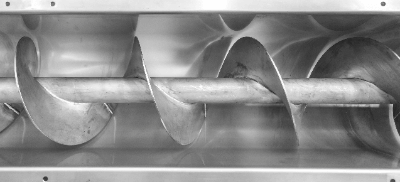What Is a Screwfeeder?

A screwfeeder is a machine that uses screw-shaped blades to feed supplies at a constant speed.
It consists of a spiral-shaped section called a flight, and supplies are fed as the flight rotates. The target objects are often powders, and the machine is used to feed a variety of materials, such as livestock feed.
With liquids, the flow rate can be controlled by opening and closing valves, but with powders, the conveying speed must be changed. In addition, changing the speed of a conveyor or other equipment at only one point may cause shelf fishing or spurting. A feeder is a device that prevents such problems and controls the feed rate.
There are various types of feeders, such as electromagnetic feeders, table feeders, etc., in addition to screwfeeders. They are used according to the required performance, such as the particle size and strength of the powder or grain to be fed, the processing volume, and the fixed-quantity feeding capability. Screwfeeders have relatively high quantitative feeding performance.
Uses of Screwfeeders
Screwfeeders are used in a variety of applications for the purpose of conveying powders.
A typical application is feed feeding in the livestock industry, where they are used to automatically feed livestock and birds on poultry farms. It is possible to supply the appropriate amount of feed according to the condition of the livestock and the time of day. Automatic feeding reduces the burden on keepers and contributes to more efficient breeding management.
They are also used at construction sites. They are used to automatically feed building materials such as concrete and cement. Screwfeeders can feed building materials at a constant speed, contributing to improved work efficiency.
They are also used for feeding raw materials in factories. They are particularly effective for automatically feeding powdered raw materials. It can feed raw materials at a constant speed, supporting stable operation of the production line.
Principle of Screwfeeders
Screwfeeders consist of spiral-shaped sections called flights, which feed material as they rotate.
Screwfeeders can control the delivery of supplies. Supply is controlled by adjusting the rotation speed, the shape of the flights, and the tilt angle of the container. Rotation speed can be controlled by employing inverters, for example.
In addition, plates called baffles may be placed between flights to control the flow of supplies. Baffles are used to control the flow of supplies and achieve uniform feeding.
Structure of a Screwfeeder
It consists of a spiral-shaped flight called a screw attached to a cylindrical container. The flights are attached to the inside of the cylindrical container and the rotation of the flights allows supplies to be fed out of the container. Flights are available in left-handed and right-handed products, selected according to the direction in which supplies are to be sent out.
Screws are available not only in vane type but also in ribbon type where the shaft itself is helical. The number of shafts also varies, including single and double shafts. Generally, these are designed according to the characteristics of the powder or grain to be conveyed.
How to Select a Screw Feeder
In screwfeeders, the driving force of conveying is the friction between the screw and the powder/pellets. Therefore, there is a risk of wear and shape breakage of the powder/pellets. To avoid this, appropriate selection of wear-resistant treatment of the screw and shape of the blades is necessary. It is not suitable for conveying coarse particles that are prone to breakage.
Selection should also be based on the properties of the material. Screwfeeders of appropriate materials must be selected according to the properties of the materials used. For example, when handling corrosive substances, it is necessary to select a screwfeeder made of highly corrosion-resistant stainless steel or similar material.
After considering the above, output capacity should be selected. The output of a screwfeeder affects the rate at which materials can be fed. The output represents the amount of material that can be fed per hour and is expressed in units such as L/h or kg/h.
Other Information on Screw Feeders
Location of Screwfeeder
Screwfeeders are generally installed at the bottom of an inverted conical powder storage container called a hopper, and the powder is pushed out and discharged by the rotation of a screw. Since the powder is pushed by the screw, it can be transported even if the container is inclined upward to some extent.
Another feature of this system is that the powder is sealed inside the screw and the hopper in the front stage, allowing interprocess conveying with pressure differences such as atmospheric pressure and vacuum. Screwfeeders with high sealing performance are used in pneumatic conveying, where the powder is carried by the airflow in the piping.